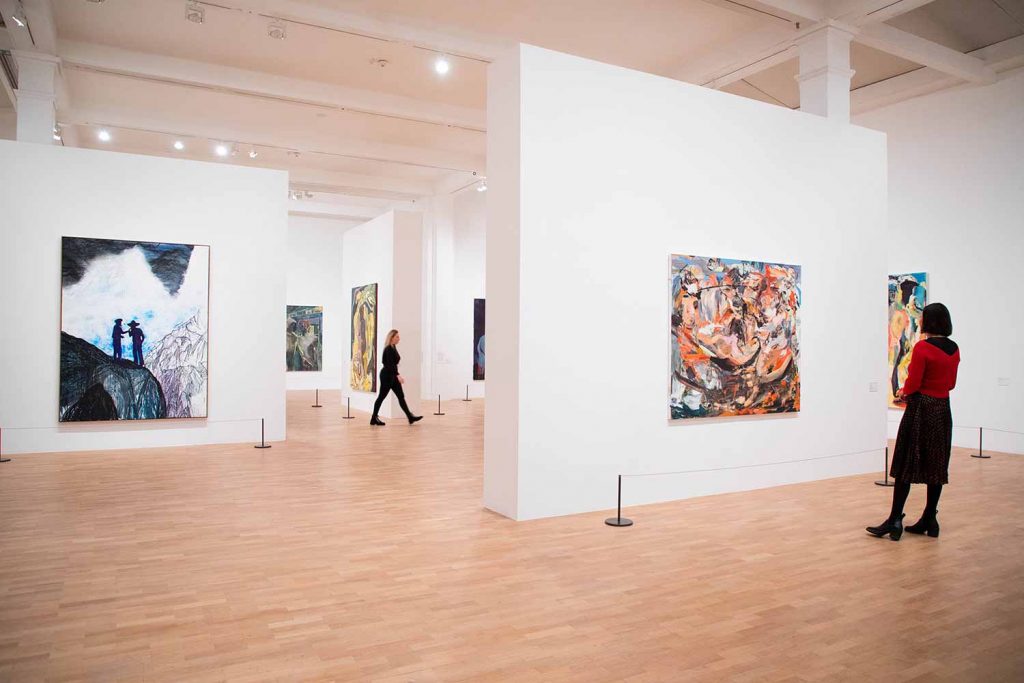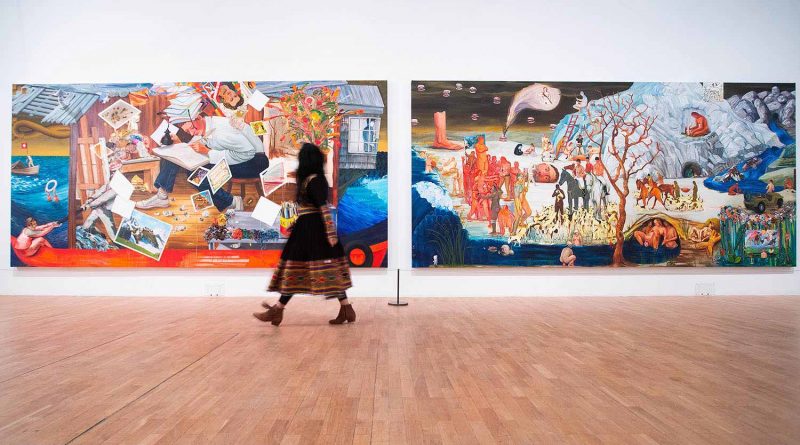Radical Figures at the Whitechapel Gallery
With galleries throwing open their doors once again after an extended hiatus, many of us will be keen to get a cultural fix. But what does the experience of visiting our local galleries look like in a post-COVID world? Our art reviewer, Rosie Wadey, decided to find out – beginning with the contemporary painting show Radical Figures at Whitechapel Gallery.
In recent months, I’ve sorely missed the calming and educational experience of spending an afternoon at a gallery. So, I jumped at the opportunity to review Radical Figures when galleries started opening after lockdown. A lot has changed since March, and visitors to the gallery are now required to book tickets for a prearranged time slot online. I had no trouble at all booking for mid-afternoon on a Saturday, which made a refreshing change from other major shows pre-lockdown.
Upon arrival at the gallery, all health and safety measures were clearly signposted and I was greeted by a small, innocuous looking screen that took my temperature when I loomed close enough to it. Having received the green light from the heat seeking robot, I moved on to a human, who kindly ran me through the measures the gallery is taking to keep their visitors safe.
Visitors are provided with masks (so there really is no excuse not to wear one), and hand sanitiser is available at entrances and exits. I had to queue for five minutes to enter the main gallery (to give those inside time to move on), and visitors leaving are encouraged to take a different exit.
Once inside, all anxiety about rules and regulations was washed away and normal service – viewing great art – resumed. Whitechapel Gallery is known for bold and varied exhibition programming, and Radical Figures does not disappoint.
The first gallery contains works by five artists whose style and subject matter differ wildly, but in the commanding ground floor gallery, the works are given space to breathe and come into their own. Cecily Brown takes the figure as a starting point and explodes it into chaotic, lavish brushstrokes, making each painting a jazz-like composition of light, colour and form. You really need to stand back to get the full effect of Brown’s work here.
Next door is Daniel Richter, a German painter whose activist background designing posters for demonstrations now lends itself to his topical subject matter. A shocking red and orange canvas depicts North African migrants making a treacherous journey via rubber dinghy. Richter’s use of colour is designed to resemble the inverted, psychedelic effect of thermal imaging equipment used by the military. Further paintings address the proliferation of internet porn, and Islamic extremist ideology. Another artist using the canvas to subvert traditional expectations of his medium is Sanya Kantarovsky. His imagery is grotesque in its darkly comic depictions. A slippery eel-like figure, a mother with bloodied knees and elbows. Long, nebulous figures caress and gaze; their intent seems malicious rather than caring. Kantarovsky’s imagery draws on influences from surrealism and Russian aesthetics, to capture the anxiety and agony of being human.
Next door is Tala Madani, the only artist in the exhibition whose works are painted on a small scale. Where Madani really excels is in her depiction of light and shadow – in one memorable work ‘Light Balance’, columns of pugnacious looking men face off, stacked on each other’s shoulders, holding torch lights that cast their beams in M.C Escher style jigsaw-like formation. The small canvases draw the viewer in to relish each detail.
You may be caught off guard by the absorbing beauty of Michael Armitage’s paintings. The London based, Nairobi-born artist uses painting to explore current affairs and political issues such as the Ugandan Anti-Homosexuality Act, and female sex tourism in Kenya. A Black figure cradles a white woman against a swirling backdrop of oranges and yellows, a group of (presumably) male legs group threateningly over a nude woman, prone on the ground. The works are painted on bark canvases, traditionally used for burial shrouds in Uganda. Upstairs, a video documents the fascinating process of bark canvas production, from tree to studio.
In the ‘Studio’, visitors have the opportunity to review sketchbooks, preparatory drawings, notes and ephemera from the studios of artists’ featured in the show. A particular favourite was Ryan Mosley’s pin-board of surrealist imagery and photographs.
The real highlight of Radical Figures is the upstairs gallery, bathed in light from its arching skylight roof. The room is dominated by Nicole Eisenmann’s huge Hieronymous Bosch-style paintings – the first depicting an artist on board a ship in tumultuous waters, the second an apocalyptic scene of creation; birth and death rendered in monstrous detail. My favourite of Eisenmann’s works here is ‘Brooklyn Biergarten II’, capturing the interior of a bar and all it’s characters with fantastic humour and detail.
Dana Schutz draws inspiration from Cubist art and German Expressionism, using elements of the absurd, and dark humour, to capture the creative process. In ‘Man Eating His Chest’, the eponymous subject does just that, whilst her subjects in ‘Suspicious Minds’ stand surrounded on all sides by fish bones and detritus. Schutz’s grotesque subject matter moves the curation on nicely to Christina Quarles, who mixes mediums to combine traditional painting with computerised techniques. Her figures contort in strange, ambiguous, almost alien forms. This layering of mediums and her tightly cramped compositions serve as a commentary on the female, Black and queer experience – so often fenced in by the confines of an unjust society.
Ryan Mosley offers us yet another modern perspective on figurative art, depicting the bust of a sexually ambiguous aristocratic figure, with multiple lips, eyes and noses contorting to a surreal and deconstructed face. His striking approach is inspired by the Old Masters, perhaps an affinity he developed when Mosley worked as a guard at the National Gallery.
The exhibition closes with works by Tschabalala Self, a young artist from New York who takes a multi-disciplined approach that encompasses painting, sewing and printmaking. Self intends to challenge stereotypical representations of black bodies, showing them as delicate, soft, and full of energy. The paintings here depict the detailed interior of a bodega convenience store, a ‘fade’ hairstyle, and a black NYPD officer, uniformed in signature blue and outlined in gentle hand sewn thread against a red brick backdrop.
With that, I made my way downstairs to the bookshop, and was thrust back out into the glaring sunshine. Radical Figures brings together a varied selection of artists using an old medium to highlight contemporary issues of gender, sexuality, race, and national identity in accessible ways. Art is an important tool to facilitate meaningful discussion, and at a time when issues of representation, instigated in part by the Black Lives Matter movement, are at the fore, the Radical Figures exhibition reveals unseen perspectives.
My time at Whitechapel Gallery was informative, welcoming and met my expectations for a safe visit to a cultural institution post-lockdown. Masks and enhanced safety measures aside, the experience was much like any other exhibition – offering some much-needed food for thought, and respite from the anxieties of day to day life.

Radical Figures: Painting in the New Millennium is on at the Whitechapel Gallery until 30 August 2020.
If you liked this article, you might also enjoy reading about how local arts organisations went digital during the pandemic.


